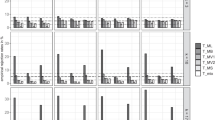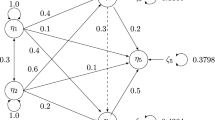Abstract
Structural equation models with mean structure and non-linear constraints are the most frequent choice for estimating interaction effects when measurement errors are present. This article proposes eliminating the mean structure and all the constraints but one, which leads to a more easily handled model that is more robust to non-normality and more general as it can accommodate endogenous interactions and thus indirect effects. Our approach is compared to other approaches found in the literature with a Monte Carlo simulation and is found to be equally efficient under normality and less biased under non-normality. An empirical illustration is included.
Similar content being viewed by others
References
Algina J., Moulder B.C. (2001). A note on estimating the Jöreskog–Yang model for latent variable interaction using LISREL 8.3. Structural Equation Modeling 8: 40–52
Anderson T.W. (1984). An Introduction to Multivariate Statistical Analysis, 2nd edn. New York, Wiley
Arminger G., Muthén B.O. (1998). A Bayesian approach to non-linear latent variable models using the Gibbs sampler and the Metropolis-Hastings algorithm. Psychometrika 63: 271–300
Arminger G., Sobel M.E. (1990). Pseudo maximum likelihood estimation of mean and covariance structures with missing data. Journal of the American Statistical Association 85: 195–203
Batista-Foguet J.M., Coenders G., Saris W.E. (2004a). A parsimonious approach to interaction effects in structural equation models: an application to consumer behavior. Working Papers d’ESADE 183: 1–28
Batista-Foguet J.M., Coenders G., Saris W.E., Bisbe J. (2004b). Simultaneous estimation of indirect and interaction effects using structural equation models. Metodološki Zvezki 1: 163-184
Bollen K.A., Paxton P. (1998). Interactions of latent variables in structural equation models. Structural Equation Modeling 5: 267–293
Boomsma A., Hoogland J.J. (2001). The robustness of LISREL modeling revisited. In: Cudeck R., du Toit S., Sörbom D. (eds), Structural Equation Modeling: Present and Future. Lincolnwood IL, Scientific Software International, pp. 139–168
Bisbe J., Coenders G., Saris W.E., Batista-Foguet J.M. (2006). Correcting measurement error bias in interaction models with small samples. Metodološki Zvezki 3: 267–287
Cohen J., Cohen P. (1983). Applied Multiple Regression/Correlation Analysis for the Behavioral Sciences. Hillsdale, Lawrence Erlbaum
Conner M., Sparks P., Povey R., James R, Shepherd R,. Armitage C.J. (2002). Moderator effects of attitudinal ambivalence on attitude-behaviour relationships. European Journal of Social Psychology 32: 705–718
Cortina J.M., Chen G., Dunlap W.P. (2002). Testing interaction effects in LISREL: examination and illustration of the available procedures. Organizational Research Methods 4: 324–60
Davis-Blake A., Broschak J.P., George E. (2003). Happy together? How using non standard workers affects exit, voice, and loyalty among standard employees. Academy of Management Journal 46: 475–485
Du Toit M., du Toit S. (2001). Interactive LISREL, User’s Guide. Chicago IL, Scientific Software International
González M., Coenders G., Casas F. (in press). Using non-linear models for a complexity approach to psychological well-being. Quality and Quantity. DOI: 10.1007/s11135-006-9032-8.
Irwin J.R., McClelland G.H. (2001). Misleading heuristics and moderate regression models. Journal of Marketing Research 38: 100–109
Jaccard J., Turrisi R., Wan C.K., (1990). Interaction Effects in Multiple Regression. Newbury Park CA, Sage
Jaccard J., Wan C.K. (1995). Measurement error in the analysis of interaction effects between continuous predictors using multiple regression. Psychological bulletin 117: 348-357
Jaccard J., Wan C.K. (1996). Lisrel Approaches to Interaction Effects in Multiple Regression. Thousand Oaks CA, Sage
Jöreskog K.G. (1998). Interactions and nonlinear modeling: issues and approaches. In: Schumacker R.E., Marcoulides G.A. (eds), Interactions and Nonlinear Effects in Structural Equation Models. Mahwah NJ, Lawrence Erlbaum, pp. 239–250
Jöreskog K.G., Yang F. (1996). Nonlinear structural equation models: the Kenny–Judd model with interaction effects. In: Marcoulides G.A., Schumacker R.E., (eds), Advanced Structural Equation Modeling. Mahwah NJ, Lawrence Erlbaum, pp. 57–89
Kenny D.A., Judd C.M. (1984). Estimating the non-linear and interactive effects of latent variables. Psychological Bulletin 96: 201–210
Klein A., Moosbrugger H. (2000). Maximum likelihood estimation of latent interaction effects with the LMS method. Psychometrika 65: 457–474
Li F., Harmer P., Duncan T.E., Duncan S.C., Acock A., Boles S. (1998). Approaches to testing interactions effects using structural equation modeling methodology. Multivariate Behavioral Research 33: 1–39
Marsh H.W., Wen Z., Hau K.T. (2004). Structural equation models of latent interactions: evaluation of alternative estimation strategies and indicator construction. Psychological Methods 9: 275–300
Mathieu J.E., Tannenbaum S.I., Salas E. (1992). Influences of individual and situational characteristics on measures of training effectiveness. Academy of Management Journal 35: 828–847
Moulder B.C., Algina J. (2002). Comparison of methods for estimating and testing latent variable interactions. Structural Equation Modeling 9: 1–19
Muthén L.K., Muthén B.O. (2004). Mplus Statistical Analysis with Latent Variables User’s Guide 3rd edn. Los Angeles CA, Muthén and Muthén
Newsom J.T., Prigerson H.G., Schulz R., Reynolds C.F. (2003). Investigating moderator hypotheses in aging research: statistical, methodological, and conceptual difficulties with comparing separate regressions. International Journal of Aging and Human Development 57: 119–150
Ping R.A. (1995). A parsimonious estimating technique for interaction and quadratic latent variables. Journal of Marketing Research 32: 336–47
Ping R.A. (1996). Latent variable interaction and quadratic effect estimation: A two step technique using structural equation analysis. Psychological Bulletin 119: 166–75
Reinecke J. (2002). Nonlinear structural equation models with the theory of planned behavior: Comparison of multiple group and latent product term analyses. Quality and Quantity 36: 93–112
Rigdon E.E., Schumacker R.E., Wothke W. (1998). A comparative review of interaction and nonlinear effects modeling. In: Schumacker R.E., Marcoulides G.A. (eds), Interactions and Nonlinear Effects in Structural Equation Models. Mahwah NJ, Lawrence Erlbaum, pp. 1–16
Saris W.E., Batista-Foguet J.M. & Coenders G. (in press): Selection of indicators for the interaction term in structural equation models with interaction. Quality and Quantity.
Satorra A. (1990). Robustness issues in structural equation modeling: a review of recent developments. Quality and Quantity 24: 367–86
Satorra A., Bentler P.M. (1988). Scaling corrections for chi-square statistics in covariance structure analysis. ASA Proceedings of the Business and Economic Section. Alexandria VA, American Statistical Association, pp. 308–313
Satorra A., Bentler P.M. (1994). Corrections to test statistics and standard errors in covariance structure analysis. In: von Eye A., Clogg C. (eds), Latent Variables Analysis: Applications to Developmental Research. Thousand Oaks CA, Sage, pp. 399–419
Schermelleh-Engel K., Klein A., Moosbrugger H. (1998). Estimating non-linear effects using a latent moderated structural equations approach. In: Schumacker R.E., Marcoulides G.A. (eds), Interactions and Nonlinear Effects in Structural Equation Models. Mahwah NJ, Lawrence Erlbaum, pp. 203–238
Schumacker R.E. (2002). Latent variable interaction modeling. Structural Equation Modeling 9: 40–54
Schumacker R.E., Marcoulides G.A. (1998). Interactions and Nonlinear Effects in Structural Equation Models. Mahwah NJ, Lawrence Erlbaum
Schwartz S.H. (1997). Values and culture. In: Munro D., Carr S., Schumaker J. (eds), Motivation and Culture. New York, Routledge, pp. 69–84
Wall M.M., Amemiya Y. (2000). Estimation for polynomial structural equation models. Journal of the American Statistical Association 95: 929–940
Wall M.M., Amemiya Y. (2001). Generalized appended product indicator procedure for nonlinear structural equation analysis. Journal of Educational and Behavioral Statistics 26: 1–29
Yang-Wallentin F., Jöreskog K.G. (2001). Robust standard errors and chi-squares for interaction models. In: Marcoulides G.A., Schumacker R.E. (eds), New Developments and Techniques in Structural Equation Modeling. Mahwah NJ, Lawrence Erlbaum, pp. 159–171
Yuan K.H., Bentler P.M. (2000). Three likelihood-based methods for mean and covariance structure analysis with nonnormal missing data. In: Sobel M.E., Becker M.P. (eds), Sociological Methodology 2000. Washington DC, American Sociological Association, pp. 165–200
Author information
Authors and Affiliations
Corresponding author
Rights and permissions
About this article
Cite this article
Coenders, G., Batista-Foguet, J.M. & Saris, W.E. Simple, Efficient and Distribution-free Approach to Interaction Effects in Complex Structural Equation Models. Qual Quant 42, 369–396 (2008). https://doi.org/10.1007/s11135-006-9050-6
Accepted:
Published:
Issue Date:
DOI: https://doi.org/10.1007/s11135-006-9050-6




